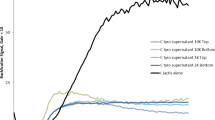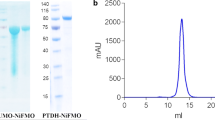Abstract
Objectives
To identify a novel nitrilase with S-selectivity toward mandelonitrile that can produce (S)-mandelic acid in one step.
Results
A novel nitrilase PpL19 from Pseudomonas psychrotolerans L19 was discovered by genome mining. It showed S-selectivity with an enantiomeric excess of 52.7 % when used to hydrolyse (R, S)-mandelonitrile. No byproduct was observed. PpL19 was overexpressed in Escherichia coli BL21 (DE3) and formed inclusion bodies that were active toward mandelonitrile and stable across a broad range of temperature and pH. In addition, PpL19 hydrolysed nitriles with diverse structures; arylacetonitriles were the optimal substrates. Homology modelling and docking studies of both enantiomers of mandelonitrile in the active site of nitrilase PpL19 shed light on the enantioselectivity.
Conclusions
A novel nitrilase PpL19 from P. psychrotolerans L19 was mined and distinguished from other nitrilases as it was expressed as an active inclusion body and showed S-selectivity toward mandelonitrile.




Similar content being viewed by others
References
Banerjee A, Kaul P, Banerjee UC (2006) Purification and characterization of an enantioselective arylacetonitrilase from Pseudomonas putida. Arch Microbiol 184:407–418
Baum S, Williamson DS, Sewell T, Stolz A (2012) Conversion of sterically demanding α, α-disubstituted phenylacetonitriles by the arylacetonitrilase from Pseudomonas fluorescens EBC191. Appl Environ Microbiol 78:48–57
Chmura A, Rustler S, Paravidino M, Rantwijk FV, Stolz A, Sheldon RA (2013) The combi-CLEA approach: enzymatic cascade synthesis of enantiomerically pure (S)-mandelic acid. Tetrahedron 24:1225–1232
Kim JS, Tiwari MK, Moon HJ, Jeya M, Ramu T, Oh DK, Kim IW, Lee JK (2009) Identification and characterization of a novel nitrilase from Pseudomonas fluorescens Pf-5. Appl Microbiol Biotechnol 83:273–283
Liu ZQ, Dong LZ, Cheng F, Xue YP, Wang YS, Ding JN, Zheng YG, Shen YC (2011) Gene cloning, expression, and characterization of a nitrilase from Alcaligenes faecalis ZJUTB1. J Agric Food Chem 21:11560–11570
Mateo C, Chmura A, Rustler S, Rantwijk FV, Stolz A, Sheldon RA (2006) Synthesis of enantiomerically pure (S)-mandelic acid using an oxynitrilase-nitrilase bienzymatic cascade: a nitrilase surprisingly shows nitrile hydratase activity. Tetrahedron 17:320–323
Raczynska JE, Vorgias CE, Antranikian G, Rypniewski W (2011) Crystallographic analysis of a thermoactive nitrilase. J Struct Biol 173:294–302
Robertson DE, Chaplin JA, DeSantis G et al (2004) Exploring nitrilase sequence space for enantioselective catalysis. Appl Environ Microbiol 70:2429–2436
Šali A, Blundell TL (1993) Comparative protein modelling by satisfaction of spatial restraints. J Mol Biol 234:779–815
Sosedov O, Stolz A (2015) Improvement of the amides forming capacity of the arylacetonitrilase from Pseudomonas fluorescens EBC191 by site-directed mutagenesis. Appl Microbiol Biotechnol 99:2623–2635
Sun HH, Gao WY, Fan HY, Wang HL, Wei DZ (2015) Cloning, purification and evaluation of the enzymatic properties of a novel arylacetonitrilase from Luminiphilus syltensis NOR5-1B: a potential biocatalyst for the synthesis of mandelic acid and its derivatives. Biotechnol Lett 38:1655–1661
Wang HL, Sun HH, Wei DZ (2013a) Discovery and characterization of a highly efficient enantioselective mandelonitrile hydrolase from Burkholderia cenocepacia J2315 by phylogeny-based enzymatic substrate specificity prediction. BMC Biotechnol 13:14
Wang HL, Sun HH, Gao WY, Wei DZ (2013b) Efficient production of (R)-o-chloromandelic acid by recombinant Escherichia coli cells harboring nitrilase from Burkholderia cenocepacia J2315. Org Proc Res Dev 18:767–773
Weatherburn MW (1967) Phenol-hypochlorite reaction for determination of ammonia. Anal Chem 39:971–974
Yeom SJ, Kim HJ, Lee JK, Kim DE, Oh DK (2008) An amino acid at position 142 in nitrilase from Rhodococcus rhodochrous ATCC 33278 determines the substrate specificity for aliphatic and aromatic nitriles. Biochem J 415:401–407
Zhang ZJ, Xu JH, He YC, Ouyang LM, Liu YY (2011) Cloning and biochemical properties of a highly thermostable and enantioselective nitrilase from Alcaligenes sp. ECU0401 and its potential for (R)-(−)-mandelic acid production. Bioprocess Biosyst Eng 34:315–322
Zhang LJ, Yin B, Wang C, Jiang SQ, Wang HL, Yuan YA, Wei DZ (2014) Structural insights into enzymatic activity and substrate specificity determination by a single amino acid in nitrilase from Syechocystis sp. PCC6803. J Struct Biol 188:93–101
Acknowledgments
This work was supported by the National Natural Science Foundation of China (No. 21406068/B060804), China Postdoctoral Science Foundation funded project (No. 2014M560308) and National Major Science and Technology Projects of China (2012ZX09304009).
Author information
Authors and Affiliations
Corresponding author
Rights and permissions
About this article
Cite this article
Sun, H., Gao, W., Wang, H. et al. Expression, characterization of a novel nitrilase PpL19 from Pseudomonas psychrotolerans with S-selectivity toward mandelonitrile present in active inclusion bodies. Biotechnol Lett 38, 455–461 (2016). https://doi.org/10.1007/s10529-015-1992-0
Received:
Accepted:
Published:
Issue Date:
DOI: https://doi.org/10.1007/s10529-015-1992-0




